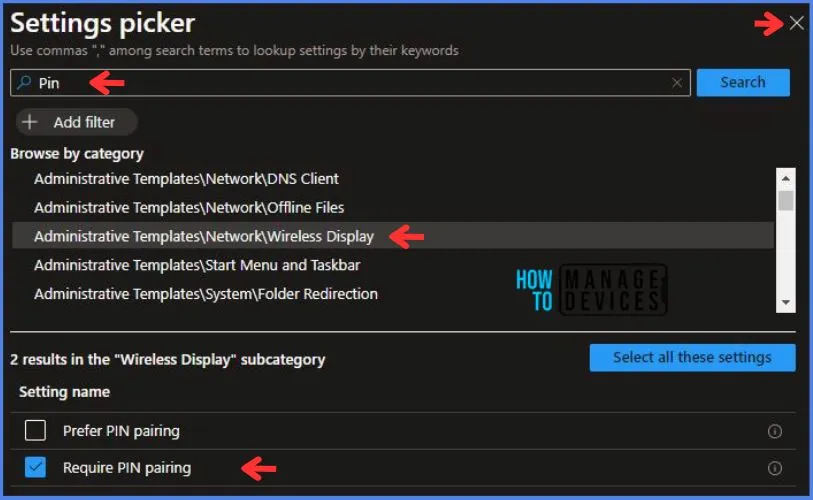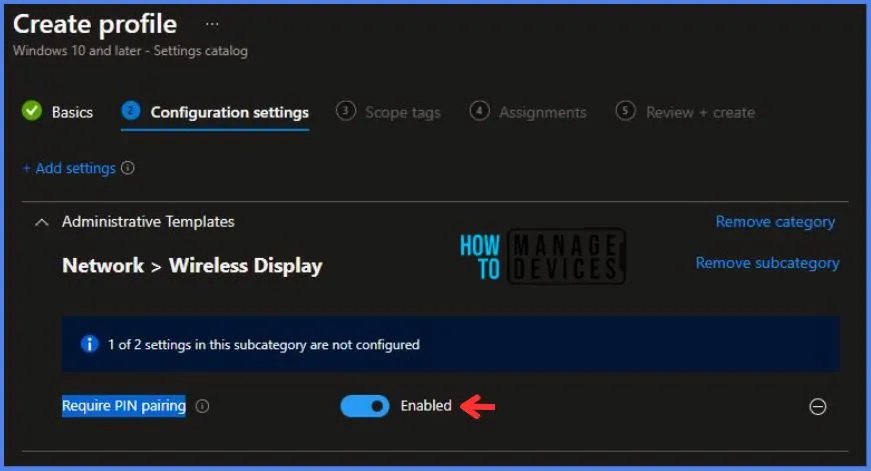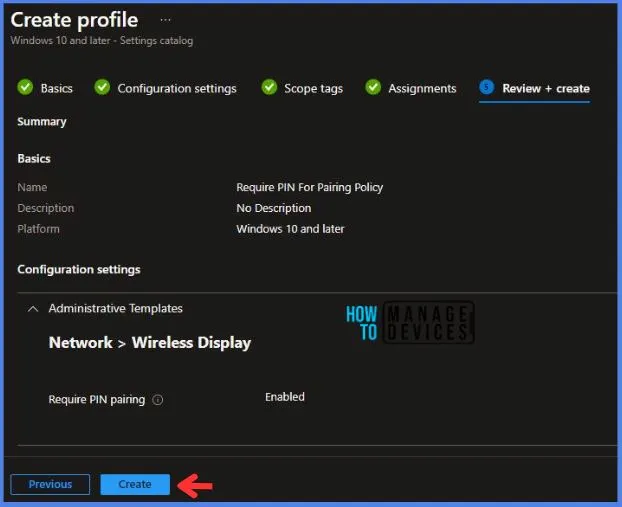This guide provides assistance with implementing the Require PIN For Pairing Policy through the use of Intune’s Settings Catalog. The task will be carried out by utilizing Intune’s Configuration Profiles.
Require PIN For Pairing Policy pertains to connections with Wireless Display devices. It mandates the obligatory use of a PIN for pairing, rendering it a requirement rather than a choice. Conversely, it signifies the prohibition of push-button pairing.
When activated, it prioritizes the use of a Personal Identification Number (PIN) for pairing with Wireless Display devices, giving precedence to this method over the Push Button pairing option. When this policy setting is either disabled or not configured, Push Button pairing is permitted by default, although it may not be the preferred method.
The Wireless Display policy specifically governs the manner in which devices establish connections with Wireless Display devices. Under this policy, utilizing a Personal Identification Number (PIN) for pairing becomes mandatory, eliminating the option for it to be merely discretionary.

Install Intune Require PIN for Pairing Policy
To create a Require PIN For Pairing Policy, follow the steps stated below:
- Sign in to the Intune Admin Center portal https://intune.microsoft.com/.
- Select Devices > Windows > Configuration profiles > Create a profile.
In Create Profile, I select Windows 10 and later in Platform and select Profile Type as Settings catalog. Click on the Create button.

On the Basics tab pane, I provide a name for the policy as “Require PIN For Pairing Policy.”
- Optionally, if you want, you can enter a policy description and proceed by selecting “Next“.

Now in Configuration Settings, Click Add Settings to browse or search the catalog for the settings I want to configure.

In the Settings Picker windows. I searched for the keyword Pin. I found the category Administrative Templates\Network\Wireless Display and selected this.
- When I select that option as stated above, I see the sub-category Require PIN Pairing. After selecting that, click the cross mark at the right-hand corner, as shown below.

Here in Administrative Templates, I have enabled the Require PIN Pairing.

Using Scope tags, you can assign a tag to filter the profile to specific IT groups. One can add scope tags (if required). More details on Intune Scope Tags Implementation Guide.
- Click Next to continue.
Now in Assignments, in Included Groups, you need to click on Add Groups and choose Select Groups to include one or more groups. Click Next to continue.

In the Review + Create tab, I review settings. After clicking on Create, changes are saved, and the profile is assigned.

After successfully creating the “Require PIN For Pairing Policy,” a notification will appear in the top right-hand corner confirming the action. You can also verify the policy’s existence by navigating to the Configuration Profiles list, where it will be prominently displayed.
Your groups will receive your profile settings when the devices check in with the Intune service. The Policy applies to the device.
Intune Report for Require PIN For Pairing Policy
From the Intune Portal, you can view the Intune settings catalog profile report, which provides an overview of device configuration policies and deployment status.
To track the assignment of the policy, you need to select the relevant policy from the Configuration Profiles list, which is the Require PIN For Pairing Policy. Then, you can review the device and user check-in status to determine whether the policy has been successfully applied.
- If you require more detailed information, you can click on “View Report” to access additional insights.

Intune MDM Event Log – Require PIN For Pairing Policy
To verify the successful implementation of String or integer policies for Require PIN For Pairing Policy on Windows 10 or 11 devices through Intune, you can leverage event IDs 813 and 814.
These event IDs provide valuable insights into the Require PIN For Pairing Policy’s application status and the specific value assigned to the policy on those devices. In the case of this particular policy, the value is a String and is linked to the event ID 814.
By analyzing these event IDs, you can gain a clear understanding of the policy’s application status and the corresponding value associated with it on the devices in question.
To confirm this, you can check the Event log path – Applications and Services Logs – Microsoft – Windows – Devicemanagement-Enterprise-Diagnostics-Provider – Admin.
MDM PolicyManager: Set policy string, Policy: (
